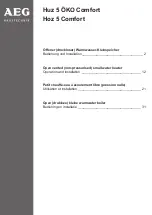
4 | 3MWTS Series Water Softeners – Installation Instructions
3MWTS Series Water Softeners – Installation Instructions | 5
CAUTION
To reduce the risk associated with property damage due to water leakage:
• Do not install if water pressure exceeds 125 psi. If your water pressure exceeds 80 psi (552 kPa), you must install a pressure
limiting valve. Contact a plumbing professional if you are uncertain how to check your water pressure.
CAUTION
To reduce the risk associated with property damage due to water leakage:
Do not install system where water lines could be subjected to vacuum conditions without appropriate measures for vacuum
prevention.
The installer is required to take appropriate measures if there is the possibility a vacuum condition may occur. This would include the
installation of an appropriate device in the supply line to the system, i.e., a vacuum breaker or backflow prevention device. Vacuum
damage voids the factory warranty.
IMPORTANT NOTE
If sediment is present, the installation of a sediment pre-filter is recommended. Even if sediment is not currently present or at a
level high enough to be objectionable, a pre-filter can help increase the efficiency of the softener and help reduce the amount of
maintenance required.
IMPORTANT NOTES
The test for Hydrogen sulfide (H2S) must be completed at the well site. For accuracy, the sample must be drawn with the pump
running, and the test be completed within one (1) minute after the sample is drawn.
Water softeners are designed to reduce hardness but can handle reasonable amounts of soluble iron if consideration is given to iron
content when selecting model and regeneration settings. To treat sulfur (hydrogen sulfide), bacterial iron, precipitated iron or very
high levels of soluble iron special equipment in addition to a water softener is required.
Congratulations! We believe your purchase of this water softener will prove to be a very wise choice. When properly installed, operated,
and maintained, your new water softener will provide years of dependable service. Before starting the installation, please read this entire
manual for an overview and then follow the installation instructions. Failure to follow the instructions will void the warranty.
Inspecting and handling your softener:
Inspect shipping carton and the equipment for shipping damage. If damaged, notify the transportation company and request a damage
inspection. Handle the equipment with care. Damage can result if dropped or if the brine tank is set on sharp, uneven projections on the
floor. When handling, do not turn the water softener unit upside down or on its side to help prevent media from entering valve and being
discharged downstream.
Make sure your water has been thoroughly tested:
An analysis of your water should be made prior to the selection of your water softener. You can typically get this service through your
place of purchase, which may require sending a sample to the factory for analysis and recommendations. Enter your analysis below for
your permanent record.
Analysis of Your Water:
Hardness
______ gpg
Tannins (Humic Acid)
______ ppm
Iron (Fe)
______ ppm
Hydrogen Sulfide (H2S) ______ ppm
Manganese (Mn) ______ ppm
Other
______ ppm
pH
______ ppm
Other
______ ppm
Check Your Pumping Rate and Water Pressure:
Two water system conditions must be checked carefully to avoid unsatisfactory operation or equipment damage:
1) Minimum water pressure required at the water softener inlet is 20 psi (138 kPa).
NOTE: Call your local water department or plant operator to obtain pressure readings. If you have a private well, the gauge on the
pressure tank will indicate the high and low system pressure. Record your water pressure data below:
Water Pressure:
Low ________ psi High ________ psi
2) The pumping rate of your well must be sufficient for satisfactory operation and backwashing of the water softener. (See
Specifications and Operating Data, Section 7)
SECTION 1: BEFORE INSTALLATION
Содержание 3MWTS Series
Страница 22: ......





































